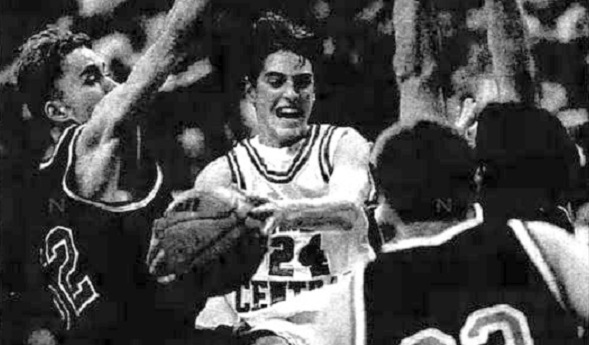
Hoops History Filled with District Stunners
By
Ron Pesch
MHSAA historian
March 9, 2018
The opinions expressed in the following are those of MHSAA historian Ron Pesch, and are not, necessarily, those of the folks who grant Pesch the chance to express them.
You are advised.
Life, sometimes, is unfair.
Despite healthy eating habits, lots of exercise, plenty of sleep, appropriate amounts of water, brain teasers, and blood pressure medicine – all those things that should, hopefully, extend a life – occasionally, our last breath arrives before the awarding of the gold watch or a trip to Disneyland.
The MHSAA Boys Basketball Tournament, sometimes, is like life. And that’s the way it should be.
The postseason is where all teams across the state are rewarded with a second chance, regardless of regular season win-loss record. In the thrilling one-and-done playoffs, highly ranked foes can be next-door neighbors or distant strangers; known only via rumor, newspaper rankings, or in these high-tech times YouTube clips. A knockout punch, ousting a team from the tournament, is most often delivered by a “worthy” opponent.
From time to time however, the end of the road arrives when least expected, via defeat by a less talented team vying for a cherished brand. “Underdog,” “Long Shot,” “Dark Horse” and “Cinderella” are the Nike®, Addias®, Reebok®, and Under Armour® of the unknown and under-achieving. Each brand is worn with pride. Everyone, including sportswriters, loves a sleeper.
In Michigan, with minor alterations, the MHSAA basketball postseason functions much as it always has operated. Champions are rare – by design, only four teams can finish the season with victory. Logistics and economics mean a team’s toughest opponent might arrive anywhere along the path. Districts are established based on schools of similar enrollment size found in logical geographic boundaries. District champions advance to play opponents in defined regions, and Regional winners move on to the final three rounds to determine those four statewide MHSAA champions. The state’s largest schools battle for the Class A title, while the smallest chase the Class D crown.
Therein lies the beauty. The playoff experience for today’s athletes is very much the same as it was for their fathers, their grandfathers and their great-grandfathers. The next opponent is luck-of-the-draw, based on a district line, and beyond a team’s control. Come game time, a blown breakaway, a bricked or air-balled jumper, or a rimmed shot that doesn’t fall can mean dreams of trophies, medals and glory, vanish from view. Tournament time does not discriminate. End game can happen to anyone.
Just like in daily life.
Sometimes, the toughest challenges arrive quicker than we feel they should. Within can be heartbreak, and, often, our greatest lessons.
Beware – the tournament tipped off again this week, and more than 120 District titles will be up for grabs tonight.
The MHSAA Tournament pre-dates Disneyland by 30 years. After assuming administrative control of high school sports in the fall of 1924, the Association made a move to expand the annual boys basketball tournament from three classifications to four with the addition of Class D in 1926.
Five years later, beginning in 1931, the public schools from the city of Detroit exiled themselves from the tournament. A year later, the schools in the Upper Peninsula did the same. Those moves, recent research shows, came from a general philosophy by local and national education authorities that there was an over-emphasis on competitive athletics. In the city of Detroit, the move meant a departure from statewide competition that would last for more than 30 years.
“The elimination of Upper Peninsula schools from state competition was the recommendation of its two (seats) on the (MHSAA representative) council,” came the report from the Lansing State Journal. “They deplored the long distances involved in sending teams from that section to the state tournament.”
Certainly, the depth of the nation’s Great Depression was a force that also insured distinct peninsula tournaments, at least in the earliest years of the separation. So, from 1932 through 1947, the MHSAA sponsored both Upper and Lower Peninsula tournaments, and crowned titlists on both peninsulas.
In 1941, and for nearly 20 years, the state’s smallest schools christened their own Class E champion. By far, the overwhelming majority were located in the vast Upper Peninsula, so it was a U.P.-only tournament.
Thereafter, a few twists of fate combined with population demographics to alter the shape of the event.
The number of schools, as well as their enrollments, played into the scheduling of action. For many years, Class A schools (as well as Class B schools for a few seasons), didn’t begin tournament play until the Regional round. Classifications were based on enrollment, with the state’s largest schools playing in Class A. Since there were relatively few Class A schools, when compared to Class C or Class D, fewer postseason games were required to identify a state champion for schools in the upper classifications. During the 1953-54 school year, there were 75 Class A schools, all in the Lower Peninsula. In Class B, there were 180 schools, (including 17 in the U.P.), while Class C included 246, (18 across the Straits). There were 181 Class D schools in the Lower Peninsula, (with 21 schools each in Class D and Class E in the U.P.). Hence, the path to a crown was, at least statistically speaking, more challenging for a smaller school.
With the post-war baby boom, and the growing size of the suburbs around the state, the first Class A Districts were held 60 years ago, in 1958. With that, the chase became more equal.
In 1961, for the first time, a Class A District tournament was held above the Straits. Played at Sault Ste. Marie, it included four teams, “with two U.P. teams, Sault and Escanaba, competing against two Lower Michigan quintets, Alpena and Traverse City,” according to the Ironwood Daily Globe.
In 1962, Detroit Public Schools ended their self-imposed exile and rejoined tournament play. With the return of those 20 schools, the first statewide prep tournament in 32 years now included 749 teams. Class A included schools with 900 or more students, Class B with between 400 and 899 pupils, Class C 200 to 399 and Class D for schools with enrollments of fewer than 200 students.
Beginning with the 2018-19 school year, basketball will move to divisions versus classifications, where the number of schools competing for a division title is uniform.
No. 1 Goes Down
Devastating District Defeats
It doesn’t happen often, but it does happen. Every now and then, Michigan’s top-ranked teams fall in the opening round of the MHSAA tournament.
1952 – Class C - Muskegon Western Michigan Christian 39, Muskegon St. Mary 36
Given little chance of surviving opening night Class C District play at Fremont High School, Muskegon Western Michigan Christian “had to do it the hard way, coming from behind with a last ditch rally that had the overflow throng on the edge of their seats.”
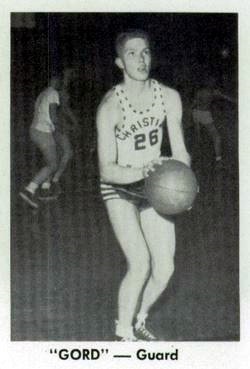 Twice beaten by St. Mary during the regular season, the Warriors opened a surprising 13-5 lead through the first quarter, behind the shooting of Gordon DeKruyter and Dave Bolema. The two seniors would end the game with high-scoring honors at 14 points apiece.
Twice beaten by St. Mary during the regular season, the Warriors opened a surprising 13-5 lead through the first quarter, behind the shooting of Gordon DeKruyter and Dave Bolema. The two seniors would end the game with high-scoring honors at 14 points apiece.
“I don’t remember much,” said the 83-year-old DeKruyter, laughing at the thought that Christian’s 39-36 victory over heavily favored Muskegon St. Mary was being recalled some 65 years later. “I’ve always thought it was hard to beat a team three times in a season. I guess that’s still the same today.”
“We had some real good contests in the old 4C Parochial League,” added DeKruyter. The league included Christian, and three Muskegon-area Catholic schools – St. Jean, St. Joseph and St. Mary. “We didn’t have our own gym back then, so we practiced on a short court at Muskegon’s Froebel School. Our coach, Elmer Wolcott, went on to win a number of state championships.”
Christian’s early lead, however, evaporated as the game quickly evolved into a real battle. St. Mary closed the gap to a point, 18-17, before the intermission, and then appeared to grab control of the game, 25-18, following the break.
“The game has seen quite a transition since those days of the set-shot,” said DeKruyter, who later played at Calvin College, then refereed for 27 years. “The biggest is the 3-point shot. It’s amazing how much it has changed the game.”
Another Christian rally knotted the contest at 31-31. The Warriors then grabbed the lead 35-33, but again lost it, trailing St. Mary 36-35 with two minutes to play. Bolema responded with a basket, and combined with a stop on St. Mary’s next possession, the stage was set for a stall by WMC for the victory. However, an errant pass, stolen with 18 seconds remaining, put the game on the line. In the vanishing seconds, filled with the pressure, intensity and noise of a win-or-go-home tournament March, St. Mary’s layup, likely separating victory and defeat, rimmed the basket and fell out.
DeKruyter snared the rebound and added an insurance basket just before the final whistle.
The celebration would last until the Regional Final. Along the way, WMC vanquished White Cloud, another surprise survivor of opening day District madness, by a point, and Lansing O’Rafferty by three, before falling by eight points to Holt.
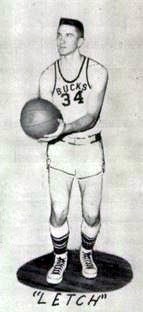 1955 – Class B – Buchanan 60, St. Joseph 57
1955 – Class B – Buchanan 60, St. Joseph 57
“It took two years but Jim Letcher got sweet revenge for a foul committed late in the district final in 1953 which gave the Bears a one point victory,” wrote Ed Lukas in the St. Joseph Herald Palladium. “Last night at the Buchanan gym, Letcher poured in 30 points to lead his Buck teammates to a 60-57 upset win over the highly touted St. Joseph Bears …”
The top rated team in Class B by the Detroit Free Press, St. Joseph had beaten Buchanan in both regular-season meetings. The winner of this matchup was expected to emerge as District champion. Indeed, Buchanan did just that, but barely, with a 47-45 win over Dowagiac. The Bucks rode the victories to the state finals, their first trip to the title game since 1928, before falling to River Rouge, 51-48, ending the year with a 17-7 mark.
1965 – Class C – Fowlerville 59, Portland 58
“Fowlerville, which did not have a winning record during the regular season, came up with the first major upset of the state high school basketball tournament Thursday night by edging previously unbeaten and top-ranked Portland, 59-58, in a Class C district … at Sexton,” wrote Ernie Boone for the Lansing State Journal. “Greg Braun, who only had six points all night and just one in the final period when Fowlerville took over the lead, sank a free throw with five seconds remaining to provide the winning margin.”
Fowlerville’s tournament run ended that Saturday as Williamston sank six free throws in the last two minutes of the District Final to emerge with a 48-46 win.
1969 – Class D – Detroit All Saints 62, Wyandotte Mt. Carmel 60, OT
“A perfect season and dreams of a state Class D basketball title went up in smoke Wednesday night before 3,000 fans for Wyandotte Mt. Carmel,” said Hal Schram in the Detroit Free Press. “Winner of 15 straight games and rated No. 1 among state powers in its division, Mt. Carmel bowed to old tormentor All Saints, 62-60, in a frenzied overtime period.
“Mt. Carmel has lost only three games in two seasons. All three losses came at the hands of the Saints.”
Detroit All Saints, reigning Class C state champ and ranked No. 3 by Schram, grabbed the District title before falling in the opening round of the Regionals to unranked Ypsilanti St. John, 65-62. Bob Sutton led all scorers with 21 for St. John in what was the upset of the tournament to that point. The Saints finished the year at 18-2.
1979 – Class A – Detroit Northeastern 95, Detroit Murray-Wright 91, OT
“Crash!! Murray-Wright High became the first big casualty of the 1979 state basketball tournament Tuesday night when the highly favored Pilots of coach George Duncan fell before underdog Northeastern, 95-91, in overtime at Highland Park High,” wrote Schram in the Free Press, describing the mayhem of the opening round to the District.
“Murray-Wright went into the game champion of Detroit’s Public School League and rated Michigan’s No 1 Class A team. But its 19-game winning streak ended when Joe Rodgers hit four straight free throws in the final 25 seconds of overtime to give the Falcons their most prized victory of the season.
“The Northeastern victory rubbed out another whirlwind comeback by Murray-Wright, which had to score 34 points in the final period to tie the game. … With 1:11 left in regulation, Northeastern led, 85-78, but the Pilots tied it with seven seconds left on Anthony White’s basket.”
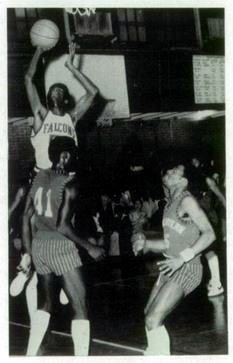 The likelihood of a rocky road to the title game for Murray-Wright was identified by Schram earlier in his write-up that accompanied his final regular-season ‘Top Ten’ rankings, a feature of the Free Press that dated back to the late 1940s. “There’s a dozen or so teams in Class A who could wind up with the big trophy. … Murray-Wright just might not get out of its own District where it has to meet and beat the likes of Northeastern, Highland Park or Northwestern.”
The likelihood of a rocky road to the title game for Murray-Wright was identified by Schram earlier in his write-up that accompanied his final regular-season ‘Top Ten’ rankings, a feature of the Free Press that dated back to the late 1940s. “There’s a dozen or so teams in Class A who could wind up with the big trophy. … Murray-Wright just might not get out of its own District where it has to meet and beat the likes of Northeastern, Highland Park or Northwestern.”
Much to the surprise of all the state’s prognosticators, unheralded Detroit Mackenzie, sporting a lackluster 13-7 regular-season mark, and preparing to celebrate its 50th graduating class that June, also got to celebrate its first basketball state title by downing Pontiac Central, 72-64, for the Class A crown.
1982 – Class C – Orchard Lake St. Mary 63, Redford St. Mary 55
“Orchard Lake St. Mary held off a late Redford St. Mary rally Monday night to defeat the No. 1 rated team in Class C, 63-55, in the first game of district play,” said Mick McCabe from the Free Press.
“Orchard Lake … jumped out to a 26-21 halftime lead despite the Rustics’ domination of the boards in the first half. Late in the third quarter, the Eaglets built up a 19-point lead but failed to deliver the knockout punch by missing a pair of wide open lay-ups before Redford scored the final five points of the period.”
Despite two losses – to Birmingham Brother Rice and Harper Woods Bishop Gallagher – The Associated Press and Detroit Free Press had ranked Redford St. Mary No. 1 in the state. With three losses – including a 79-77 defeat to Class A Detroit Cooley decided during the final 25 seconds – Orchard Lake St. Mary sat No. 2 in the Free Press’ final poll, while AP had the Eaglets at No. 4.
Orchard Lake led by 14 midway through the final frame, but Redford went on a 9-0 run to pull within five before running out of steam. Chris Howze scored 20 points on 8 of 12 shooting from the field to lead Orchard Lake to victory. Following the win, the Eaglets tore through Class C mostly uncontested until the Semifinals. Trailing by as many as 17 in the first half, Grand Rapids South Christian, a final four contestant in the previous two years, capitalized on the loss of Howze to fouls with 5:57 to play. Able to cut the margin to three with 21 seconds remaining, the Sailors couldn’t complete the furious comeback, and fell, 66-63. Orchard Lake coasted to the crown Saturday, thumping unranked Reed City, 76-48.
1995 – Class D – Detroit Holy Redeemer 75, Detroit East Catholic 66
“Hamtramck St. Florian will host the state’s second-best (opening round District) game when Detroit East Catholic (No. 1 in Class D) and Detroit Holy Redeemer hook up again,” noted McCabe in his pre-tournament column in the Free Press. “In the (Detroit) Catholic League semifinals, East Catholic got off to a huge lead against Redeemer and then hung for the victory.”
(The state’s top District opener, referred to by McCabe, ended as expected. Detroit Country Day, ranked No. 1 in the Free Press Class B rankings, rolled to an easy 55-48 victory over Orchard Lake St. Mary, the state’s No. 3 team. Sophomore Shane Battier scored 28, grabbed 11 rebounds and blocked three shots.)
McCabe had noted Redeemer’s senior guard Jimmy Reyes hadn’t played that well in the Catholic League final. Reyes certainly had his game in the rematch as he scored 20 points, including 13 in the fourth quarter, to lead the No. 6-ranked Lions to victory. Sophomore guard Armelius Parker added 17 as Holy Redeemer began its march to the Class D title.
The rivalry between the schools would continue in the coming years. Redeemer would again knock East Catholic out of the postseason in the District Final in 1996. East Catholic extracted some revenge in 1997, downing the Lions in the second round of the District, en route to its eighth and final MHSAA basketball championship. Both schools would close following the 2004-05 school year.
1997 – Class C – Benzie Central 73, Manton 70
In the opening game of the District 91 doubleheader, played at Benzonia, senior Nate Myers bagged eight 3-pointers, including the game winner with eight seconds remaining, as Benzie Central downed unbeaten and top-ranked Manton in the Class C District opener, 73-70. Benzie had lost an 11-point lead over the final four minutes.
“The gym was unbelievably full,” recalled Bill Lynch, a former coach at Benzie Central. “Just a great crowd. As I recall, Manton didn’t come down early to practice in the gym. I thought that was a mistake.”
Following the victory, Benzie Central cruised to the Semifinals before falling to Three Oaks River Valley in a frenzied 67-65 thriller. Trailing by 14, River Valley rallied back and was up three, 65-62, when Myers again bagged a clutch triple with just 11 seconds remaining to knot the game. But Zac Robinson would emerge as the game’s hero with a lay-up with 3.1 seconds remaining that hung on the rim “for an agonizing split second” before dropping through the net, ending Benzie Central’s dream run.
2004 – Class A – Grosse Pointe North 66, Detroit Denby 51
“Out of all the teams, that was the one team I was really concerned with,” said Detroit Denby coach Ray Reeves to McCabe about the draw of his team’s opponent prior to its Class A District opener with No. 9 Grosse Pointe North. “We beat them last year by 14, but it was a tough game. We made them play our style, and it wore them down.”
His concerns were warranted. Trailing by six to open the final quarter, North’s Mark Bramos scored 15 of his 25 points in the fourth as North toppled No. 1 Denby, 66-51, in Class A opening round District action.
“We saw them play Renaissance at Cobo, and that helped us a lot,” said guard Bryan Bennett, who scored 11 points for North. The Norsemen won the District, downing two more PSL squads Southeastern and Finney, but lost to eventual quarterfinalist Utica Eisenhower, 56-52, in their Regional opener.
 Ron Pesch has taken an active role in researching the history of MHSAA events since 1985 and began writing for MHSAA Finals programs in 1986, adding additional features and "flashbacks" in 1992. He inherited the title of MHSAA historian from the late Dick Kishpaugh following the 1993-94 school year, and resides in Muskegon. Contact him at [email protected] with ideas for historical articles.
Ron Pesch has taken an active role in researching the history of MHSAA events since 1985 and began writing for MHSAA Finals programs in 1986, adding additional features and "flashbacks" in 1992. He inherited the title of MHSAA historian from the late Dick Kishpaugh following the 1993-94 school year, and resides in Muskegon. Contact him at [email protected] with ideas for historical articles.
PHOTOS: (Top) Benzie Central’s Nate Myers drives between Three Oaks River Valley defenders in 1997. (Middle top) Muskegon Western Michigan Christian’s Gordon DeKruyter in 1952. (Middle) Buchanan’s Jim Letcher in 1955. (Middle below) Fowlerville’s 1965 team. (Below) Detroit Northeastern’s Joe Rogers puts up a shot in 1979. (Photos courtesy of Ron Pesch.)

Pershing Sends Robinson Into History with Historic Title Run
By
Ron Pesch
MHSAA historian
March 4, 2021
Just 48 hours before the kickoff of the 45th annual MHSAA Basketball Finals, Illinois State University broke the news that it would hire Detroit Pershing high school coach Will Robinson as the new head of its men’s basketball team.
Before the days of Good Morning America, CNN and ESPN, there was no immediate mention that ISU and the 58-year-old North Carolina native had broken a color line.
Robinson had played high school sports in Steubenville, Ohio, where he won 14 letters in five sports. He then earned a combined 15 letters and served as captain of the football, baseball and gymnastics teams at West Virginia State College, noted the ISU student newspaper, The Vidette, and then served five years as athletic director for YMCA in Pittsburgh and Chicago.
He followed by embarking on a high school school coaching career that would include more than a quarter-century at Detroit schools before he'd move on to become, at ISU, the first African-American head coach of an NCAA Division I college program.
But before beginning that history-making tenure, he guided what remains one of the most memorable, and unexpected, championship triumphs in Michigan high school hoops history.
Coach Rob
“It was shortly after the race riots of 1943 that Warren Bow, then the superintendent of schools, lured Robinson from DuSable High of Chicago,” stated veteran sportswriter Hal Schram of the Detroit Free Press years later. With the arrival of the 1969-70 season, Robinson had spent the previous 26 years as coach in Detroit, arriving at Detroit Miller in 1944. He moved to Detroit Cass Tech in the fall of 1957 when Miller became a junior high, then to Detroit Pershing in the fall of 1961.
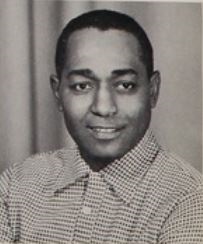 “We had plenty of applicants and interviews from nearly 100 men,” Milt Weisbecker, athletic director at ISU, told the press about the hire on Saturday, Feb. 28. “We feel Will is the man we want. He impressed us with his sincerity and his desire to succeed. We feel he’ll be an excellent recruiter.”
“We had plenty of applicants and interviews from nearly 100 men,” Milt Weisbecker, athletic director at ISU, told the press about the hire on Saturday, Feb. 28. “We feel Will is the man we want. He impressed us with his sincerity and his desire to succeed. We feel he’ll be an excellent recruiter.”
Robinson’s departure for the college ranks would depend on how long his Pershing team hung around the state tournament. The Doughboys had ended the 1969-70 regular season with an 8-4 record.
“Pershing is not one of the favorites,” noted Schram, “but neither was it in (1961-62) when Robinson took a team with a 4-8 record to the Class A semifinals. Then in 1967 Pershing went all the way to a State title with Spencer Haywood and Ralph Simpson as its top stars.”
Earlier in the year, Schram had reminded readers of the Detroit Public School League’s self-imposed boycott that kept city schools away from outstate competition and the MHSAA postseason tournament from 1930-1961.
“For many years, Detroit’s public schools (considered themselves) the best in Michigan,” he explained. “The boast could not be answered, because until 1961 the Detroit teams were not permitted (by school administration) to leave their area. In the years since their return to the state tournament, however, the locals have done little to support the earlier boast. With one exception (they’ve) fallen flat in the State tournament.”
That one team was Robinson’s 1967 champs.
Wealth of Talent
While, as usual, four basketball teams would finish 1970 as Finals champs, Class A was of particular interest to many around the state. The classification was packed with court talent. While the senior class included players of wide-ranging skills, a collection of incredible underclassmen would have the most impact on the postseason.
Based on Schram’s season-ending rankings, Ferndale was his pick to win it all in Class A. The Eagles had previously grabbed titles in 1963 and 1966 in the MHSAA’s classification featuring the schools with the largest enrollments. Each championship had come under current coach Roy Burkhart’s leadership.
“Ferndale has one major challenger – Pontiac Central,” said Schram. “This has been a Ferndale-Pontiac Central year in Class A,” he noted in his pre-tournament preview. “Both own 16-0 records. Providing they both survive district, regional and quarter-final eliminations these two rivals could tangle in either the semifinals or finals …”
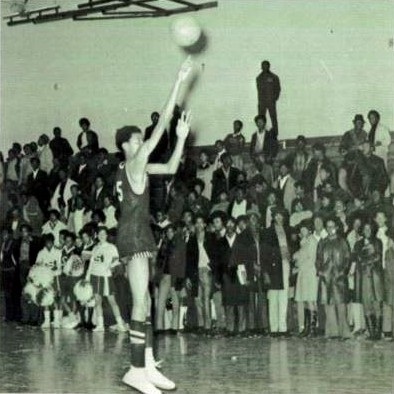 He acknowledged “second-line challengers” could be found among Birmingham Seaholm, his third-ranked team; Detroit Kettering, the top team in the PSL, led by 6-foot-4 senior Floyd Haywood (Spencer’s brother) and junior Lindsay Hairston; Detroit Martin Luther King, second in the PSL and powered by senior George ‘Twiggy’ Gervin (named one of the 50 greatest players in NBA history in 1996 - ‘The Iceman’ nickname would come later); Detroit Northeastern and star guard Mike Robinson (who would go on to set a Michigan State University all-time scoring mark and twice lead the conference in scoring despite previous doubts of if, at 5-foot-10, he could play Big Ten basketball), Battle Creek Central, with all-state selection Dave Freeman; Grand Rapids Union, featuring 6-foot-5 senior Gerald Edwards; Grand Rapids Ottawa Hills, seeking its third-straight Class A crown; and twice-beaten Flint Central, led by Mike DeCou and Bob Stone.
He acknowledged “second-line challengers” could be found among Birmingham Seaholm, his third-ranked team; Detroit Kettering, the top team in the PSL, led by 6-foot-4 senior Floyd Haywood (Spencer’s brother) and junior Lindsay Hairston; Detroit Martin Luther King, second in the PSL and powered by senior George ‘Twiggy’ Gervin (named one of the 50 greatest players in NBA history in 1996 - ‘The Iceman’ nickname would come later); Detroit Northeastern and star guard Mike Robinson (who would go on to set a Michigan State University all-time scoring mark and twice lead the conference in scoring despite previous doubts of if, at 5-foot-10, he could play Big Ten basketball), Battle Creek Central, with all-state selection Dave Freeman; Grand Rapids Union, featuring 6-foot-5 senior Gerald Edwards; Grand Rapids Ottawa Hills, seeking its third-straight Class A crown; and twice-beaten Flint Central, led by Mike DeCou and Bob Stone.
“A successful tournament run by any other Class A quintet,” said Schram, “would be a major upset.”
Both The Associated Press and United Press International agreed with the Free Press on the top two schools, but each named Pontiac Central, led by Campanella ‘Campy’ Russell, as the top team in Class A in their respective regular-season polls, with Ferndale finishing second in the rankings.
“Take it from a couple college coaches who should know,” wrote Bob Gross from the Lansing State Journal, “the best Class A high school basketball teams in Michigan are Pontiac Central and Detroit Kettering. Michigan State’s Gus Ganakas likes Pontiac and 6-6 junior Campy Russell while Michigan’s Johnny Orr leans toward Kettering and 6-7 Lindsay Hairston.”
“I’ve seen a lot of outstanding teams,” Ganakas told Gross, “but Pontiac is solid. In Russell, they have a player who is tremendously strong on the boards as well as scoring.”
“Kettering looks very strong to me,” noted Orr. “I haven’t seen Pontiac or Ferndale but my assistants have and they tell me both are excellent teams. … Ypsilanti and Battle Creek Central also are fine teams.”
Kettering had finished third in the AP poll, fourth according to UPI but eighth in Schram’s “Top Ten.”
Ypsilanti, noted Gross, had lost to Ottawa Hills in the Class A title game a year before, and was coming on strong. The Bearcats of Battle Creek Central, had “sailed through the Six-A League and posted a 16-1 record losing only to Ann Arbor Huron in one of the state’s biggest upsets.” The Bearcats finished the regular season at No. 3 according to UPI, and were ranked No. 4 by both the AP and the Free Press.
Change in Format
The 1970 tournament would mark the end of a three-week postseason format that had been in place since Michigan State’s Jenison Field House had opened in 1940. Beginning the following March, the playoffs would expand to a four-week schedule with the Semifinals and Final contests played over separate weekends. In addition, the annual championship games would begin alternating annually between Jenison and Crisler Arena at the University of Michigan.
“Our major interest is to use the best possible facilities,” said Allen Bush, executive director of the East Lansing-based MHSAA, no doubt smiling with his next statement. “After all, Michigan is also a state school.”
Bush had earned multiple bachelor’s degrees from Western Michigan University and his master’s in school administration from U-M.
Crisler Arena, opened in 1967, could handle a crowd of 14,000.
Typical of the era, the more than 12,000 available tickets for the pending four championship games at Jenison were already sold out or were being held for distribution to the schools competing in the finals.
Tipping Off the Tournament
The Class A casualties to favorites during the opening week of play were minimal. Seaholm, with two regular-season defeats – both to unbeaten Ferndale – departed in its playoff opener against Birmingham Groves.
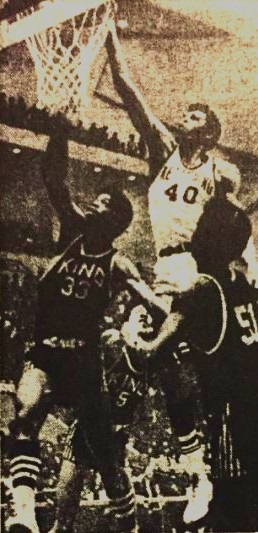 Fouls and turnovers nearly cost Ferndale its tournament life in its opener against Oak Park. With stars Tyrone Lewis and Billy Screws both in early foul trouble, the Eagles clung to a slim 35-33 lead with five minutes remaining, before escaping with a 45-39 win.
Fouls and turnovers nearly cost Ferndale its tournament life in its opener against Oak Park. With stars Tyrone Lewis and Billy Screws both in early foul trouble, the Eagles clung to a slim 35-33 lead with five minutes remaining, before escaping with a 45-39 win.
Kettering met Northeastern in a much-anticipated thriller in the District Final. Northeastern, with 15 of its 17 players now seniors, had advanced to the Class A Semifinals in March 1969. The teams had split their regular-season matchups in 1969-70. Boasting a distinct height advantage, Kettering had won by two points at Northeastern, 87-85, in mid-December with Hairston scoring 35 points, but the speedy Falcons, double-teaming Hairston, downed Kettering by eight points 86-78 at Kettering in a February rematch. Robinson scored 27 points and Mike Weaver, who later played at Michigan, notched 19 for Northeastern while Haywood tallied 27 for Kettering. Hairston was held to 14.
“We deserved to lose that game,” Kettering coach Walt Jenkins told the Free Press. “They got us to play their game instead of ours. I don’t think it will happen again ...”
Kettering blew a nine-point lead after one period but fought back to win 96-93 as Hairston scored 42 and pulled down 25 rebounds. Robinson finished with 41 points. “Northeastern’s hopes of upsetting Kettering were hampered when three players fouled out in the second half.”
Week 2
The Regional round brought much more excitement.
Ferndale escaped the Regional Semifinal “with a heart-pounding 66-64 victory” over Detroit Cooley. The Cardinals, 7-4 on the regular season, used their height advantage to create problems for Ferndale. Deadlocked at the end of both the first and second quarters, the Eagles led by 10 late in the fourth quarter before Cooley’s press interrupted things. Cooley cut the lead to two with nine seconds remaining before Ferndale was able to run out the clock. Lewis finished with 26 to lead the victors.
Ypsilanti fell on the same night, 76-70, to Detroit Catholic Central in overtime. Leading 67-64 with 16 seconds remaining, four points by DCC’s Frank Tanana Jr., including a layup with eight seconds left, knotted the score at 67-67 to force overtime. A pair of clutch field goals by Mark Barczuk in the extra frame ended Ypsilanti’s season. Tanana and Terry Frye both finished with 24 points on the night.
The Regional Final round tossed a few more favorites to the sidelines.
“Unrated and unsung … an also-ran in Public School League play, Will Robinson and his Pershing High Doughboys burst the Ferndale basketball bubble Saturday night” wrote Schram in the Free Press.
A crowd of 2,200 packed Southfield High’s gymnasium for Ferndale’s Regional Final game with Pershing.
The Eagles opened a quick 8-0 lead, and upped the lead to 10 points with three minutes to go in the first half before Pershing cut the margin to two, 41-39, at the break. By night’s end, 6-foot-4 sophomore Robert Hawkins had tallied 39 points, while 6-foot-8 junior Calvin Harper added 19 and 17 rebounds as Pershing scored a 90-88 upset.
In other Regional Final action, the Tractors of Dearborn Fordson, 17-3 on the year, held high-scoring George Gervin scoreless in the third quarter and to 17 points overall to upended Detroit Martin Luther King’s run, 64-62, while Ottawa Hills succumbed to Union. The Red Hawks had defeated the reigning champ twice during the regular season. Tradition-rich Benton Harbor upset Battle Creek Central, 88-85 in overtime.
 Also among the surprises, Flint Central, beaten by Pontiac Central by just 10 points early in the year, fell to unranked Midland 72-71 on a tip-in by Chemics senior guard John Reding with seven seconds remaining in their Regional Final. The teams had split a two-game series during the regular season.
Also among the surprises, Flint Central, beaten by Pontiac Central by just 10 points early in the year, fell to unranked Midland 72-71 on a tip-in by Chemics senior guard John Reding with seven seconds remaining in their Regional Final. The teams had split a two-game series during the regular season.
Pontiac Central trounced Birmingham Brother Rice, 60-39 in a game filled with offensive stalls by Rice.
Garden City West, led by 6-foot-7½ senior Rick Drewitz, were the tournament’s heart attack kids. Undefeated during the regular season, the Tigers finished at No. 6 according to the UPI poll, ninth in the Free Press, and 10th by AP. West had advanced to the MHSAA Regional Finals in 1969 when its line-up also included Rick’s older brother Duane, but, for whatever reason, the Tigers weren’t initially mentioned as a threat in 1970.
Following an easy 62-37 win over Livonia Franklin in their District opener, indeed it seemed that it was only a matter of time before West departed from the postseason.
Drewitz poured in an eye-popping 48 points in the team’s 71-67 victory over Livonia Bentley, but it had taken overtime and a last-second field goal in regulation to get there. Drewitz’s jumper off the free throw line at the buzzer had knotted the game, 64-64.
In the District Final, with Drewitz benched with fouls, junior Dennis Leszczynski drilled a field goal and a pair of free throws over the final 32 seconds to give West a 58-55 win over Livonia Stevenson.
Garden City had opened up a 40-30 third quarter lead over Ann Arbor Huron in its Regional opener when Drewitz was whistled for his fourth personal and headed for the bench. Huron quickly grabbed the lead, 44-43 before the big center returned in the final frame. Drewitz, who ended with 19 points, sank two key free throws with 90 seconds left, allowing the Tigers a 55-52 win over the River Rats, who finished the year at 10-10.
The Tigers slipped past Detroit Catholic Central 72-71 in the Regional Final – a foul-filled contest. Drewitz, who would play his college ball at Kentucky, was held to only five field goals, but nailed 20 of 25 free throws to lead all scorers with 30 points. Tanana, dealing with a bad ankle, limped through much of the match, and was held to 10 points. West sank 38 of 52 free throws on the night as officials called 55 infractions during the contest. A total of six players fouled out.
Quarterfinals
Upwards of 75,000 fans were expected to witness the four classes of MHSAA Quarterfinals hosted at 14 centers around the state. But without question, Crisler Arena was the place to be on that Wednesday night. The lone site with two Class A contests, Pershing would face Fordson in the 4:30 opener. The dream matchup between Pontiac Central and Detroit Kettering, and “the finest two big men to come out of the state in recent years,” juniors Russell and Hairston, was set for an 8 p.m. tipoff. Separate tickets were needed for each game, and the event had been sold out since the start of the month.
The matchup, won by Pontiac Central, 76-73, was everything it was expected to be. High drama came late in the third period when Russell, who finished with 32 points – 22 in the first half – twisted an ankle. But, as Jack Saylor told Free Press readers, “it was a pair of free throws by Jerry Ratliff with 42 seconds left that provided the Chiefs with their victory margin.”
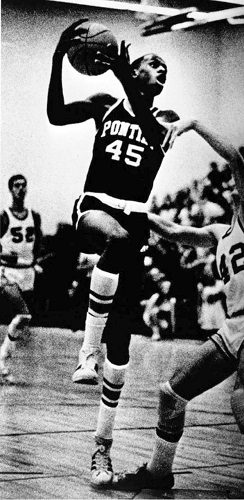 “After Ratliff’s foul shots had given Central a 74-70 lead, (Kettering’s) Floyd Haywood rammed in a rebound and completed a three-point play with a foul shot. Fifteen seconds remained, the Chiefs were out of time outs and Kettering (down by a point) was applying frantic pressure.”
“After Ratliff’s foul shots had given Central a 74-70 lead, (Kettering’s) Floyd Haywood rammed in a rebound and completed a three-point play with a foul shot. Fifteen seconds remained, the Chiefs were out of time outs and Kettering (down by a point) was applying frantic pressure.”
Kettering’s defeat was sealed when Pontiac guard Bill Glover, boxed in following the inbound pass, spotted Russell, who had returned to action with six minutes remaining, at the other end of the Crisler court. Glover’s intended pass was off the mark, instead falling “through the hoop, fully 85 feet away.”
“Until then, the game belonged to Russell, who had a clear margin over Lindsay Hairston in the battle of junior All-Staters.” Hairston led Kettering with 18 points, followed by Joe Johnson (who would play college ball at U-M) with 11. Ratliff added 18 for the Chiefs.
The game was the last for Kettering coach Jenkins, who had played football for Will Robinson at Miller and was now moving into administration as a high school principal.
Pershing’s starters went the distance, with four of the five scoring in double figures, ending Dearborn Fordson’s run, 73-61. Harper led Pershing with 24 points. Behind an outstanding all-around performance, Fordson’s Steve Burke, a 6-foot-3½ forward, topped all scorers with 26 points.
Garden City West easily turned back Benton Harbor in the Quarterfinals, 82-66. Drewitz grabbed 19 rebounds, scored 13 of 14 from the charity stripe and totaled 39 points on the night. “Benton Harbor’s fast break and full-court press troubled West most of the first half,” stated Curt Sylvester of the Free Press, “but strength on the boards and ability to get the ball in to Drewitz for his soft left-handed jumpers finally tipped the balance for Garden City.”
“(Drewitz is) everything they said he was,” Benton Harbor coach Ace Eisner told the Benton Harbor News-Palladium. “He rebounds well, he has a nice touch and he goes to the basket. Defensively, we just couldn’t stop him …”
A 15-foot bucket with 38 seconds remaining by John Reding followed by a Jeff Paulus free throw with seven ticks left on the clock gave Midland a 71-68 upset of Grand Rapids Union. Gerald Edwards finished with 21 points for Union, while Tom Pruss’ 19 points led the Chemics. It was a season to remember for Midland, as it nearly didn’t take place. According to John Kennett, a reserve on the Chemics team and later a part-time sportswriter for the Midland Daily News “ … residents of Midland had voted down a millage proposal earlier in the year. As a result, all extra-curricular activities were to be eliminated. Fortunately, a group of citizens and students banded together to raise enough funds to maintain the extra-curricular activities.”
‘The Last Extravaganza’
“They’re calling this State Tournament the last of the great extravaganzas,” wrote Free Press sports editor and columnist Joe Falls. “It’s the last time they’re having this two-day carnival in Jenison Fieldhouse. Next year they’re changing the format, and the site. … They’re spreading the tournament over four weeks instead of three and there is going to be no Friday-Saturday climax in East Lansing.
“Half of the fun is planning a big weekend in East Lansing. The mad scene here is something else. You can feel the swirl of excitement everywhere … in the hotel lobbies, the restaurants, the hamburg stands, the bars … as everyone is talking about these kids and the games they play …
“If anything, U-M’s, facility, the gleaming new Crisler Arena, is far superior to old Jenison Fieldhouse, where the fans sit on benches rather than in seats and the game is only a rumor in some corners of the end court sections.”
The Marathon
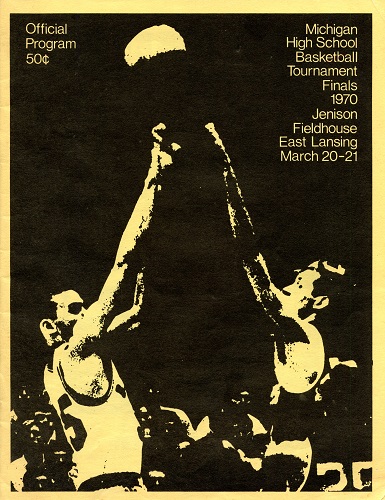 Three of the four Class A semifinalists making the trip to Jenison – Pershing, Midland and Garden City West – were unexpected guests.
Three of the four Class A semifinalists making the trip to Jenison – Pershing, Midland and Garden City West – were unexpected guests.
“Robinson’s Pershing team and its semifinal opponent, Midland, both qualify as ‘Cinderella’ teams,” wrote John Hill of the State Journal in his tourney preview. The Chemics had also been beaten four times during the regular season. “Midland is a smart, well-disciplined team that doesn’t commit many errors.”
Pershing’s success had been a surprise to everyone. The Doughboys had lost three seniors, including their best player, Paul Seals, to January mid-year graduation. According to Coach Robinson, the current squad was his second team – his bench. The coach recognized the skills of the 15-year-old sophomore, Hawkins: “He WILL be a good ballplayer … but he’s got a long way to go yet and he’s got a lot to learn.”
In Hill’s opinion, the Pontiac Central-Garden City West showdown – the last Semifinal game of the night at Jenison – might be the tournament’s premier contest. “Not only do both bring unblemished records to the game, but each has one of the state’s top players” in Russell and Drewitz.
As it turned out, Pershing completely dominated Midland in their contest as the Chemics were “outshot, outrebounded, and out defensed,” in their 82-71 loss. Only a strong finish saved them from a worse defeat. At game’s end, Pershing had launched 82 shots to Midland’s 68, hitting on 42.7 percent to the Chemics 39.7. The Doughboys ended with a 55-40 rebounding advantage. Hawkins scored 22 points in the opening half, and finished with 31. Harper fouled out, but added 24 points and a game-leading 17 rebounds before his departure.
Robinson, however, wasn’t pleased.
“I wasn’t particularly inspired by the performance,” he said. “Calvin fouled out stupidly. … We’ve worked too long and too hard to make so many silly mistakes. We can’t make those kinds of mistakes tomorrow.”
As predicted, the Central-West matchup was a classic.
“Pontiac Central may indeed be, as a growing number of the ‘experts’ think, the best prep overall basketball team to ply its trade in Michigan since the last of the great Benton Harbor clubs,” stated the State Journal about the Chiefs’ 84-79 victory over Garden City West. “Deadly though they may be, however, the undefeated Chiefs had all they could do Friday to withstand the largely single-handed upset bid of brilliant Garden City West pivotman Rick Drewitz.”
Russell “could do little to slow Drewitz,” who scored 42 points, a Class A Semifinal mark that would hold for 13 years. With multiple ties and lead changes throughout, Garden City trailed by one, 79-78, with 1:40 left to play. But Drewitz – who had scored 15 points in the fourth quarter – picked up his fifth personal with 1:12 remaining, and “Garden City’s hopes went to the bench with him.”
Russell ended with 31 points, but dominated the backboard with 25 rebounds. Many compared the contest to the Dave DeBusschere-Chet Walker, Detroit Austin-Benton Harbor championship game match-up from 1958, won by Austin, 71-68.
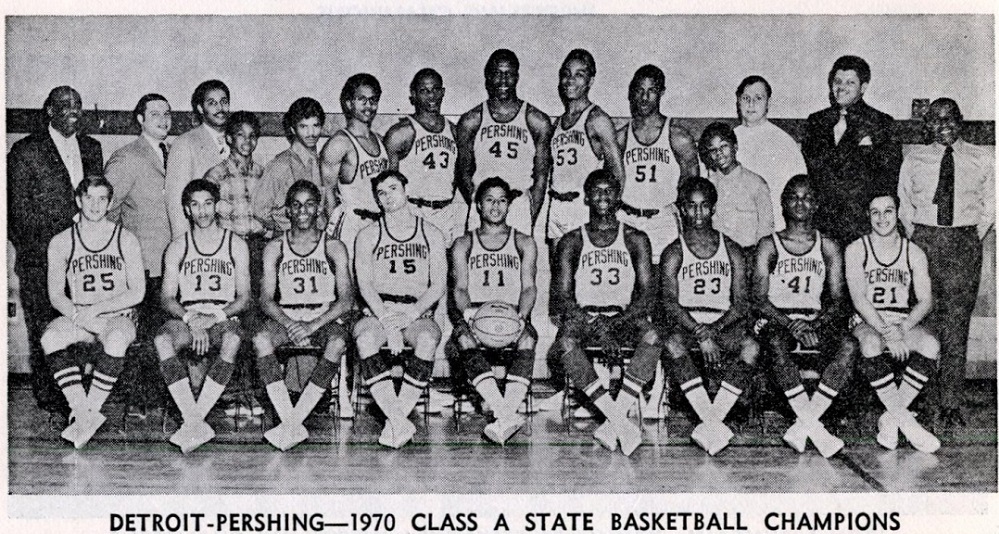 Coach Robinson and his team watched the battle, studying their opponent. The coach was impressed with Pontiac Central.
Coach Robinson and his team watched the battle, studying their opponent. The coach was impressed with Pontiac Central.
“They have more height than we do, more speed, more stamina, more poise and they’re an older team,” said Robinson. “But this is one I want.”
Circumstances made Pershing the sentimental favorite, but by all accounts, still the underdog entering the contest.
Storybook Ending
“Pershing High basketball squad staged one of the greatest upsets in Michigan high school tournament history here Saturday night before a steaming, screaming crowd of over 12,000 spectators in Jenison Field house,” exclaimed Schram in the Sunday paper.
“The Doughboys, loser of four games during the regular season, knocked off previously unbeaten Pontiac Central 86-81 in a real shocker.” The Swami, as he was nicknamed, had picked Pontiac to win.
“I know we’re the underdog. … I know few think we can win it,” Robinson had told 500 coaches at the annual banquet of the Michigan High School Coaches Association a couple of hours before tip. “But I’ve got a feeling.” Robinson was in attendance as he was being inducted into the coaches association Hall of Fame.
With the win, Pershing’s team had delivered a beautifully wrapped going away present to the coach.
“In the early going … it looked like the Chiefs would run away with it,” continued Schram. “Pontiac pounded to a 10-4 lead and Robinson called a hasty time out. Robinson sent … Harper to the low post crowding the basket and Harper started a fantastic series of easy layups, turn-around jumpers and tip-ins.” He finished with 24 points.
“Tiny (5-foot-6) but very aggressive guard Phil Paige … got them out front to stay by sparking a 23 point second period with 13 points,” noted the State Journal. The Doughboys’ captain, Paige would finish with 19 on the night.
“Late in the second period, Harper and Darrel Jeter started hitting the boards and Pershing continued to click on its shots,” continued the Free Press. “The Doughboys worked out a six-point lead, 39-33, at halftime.
“The Doughboys maintained the six-point margin in the third quarter, 64-58,” added the Detroit News. “Four times in the final quarter, however, Pontiac slashed Pershing’s lead to two points – at 70-68, 72-70, 74-72 and 76-74. With 2:23 left, Hawkins sank two free throws and … Jeter tipped in a field goal to give Pershing an insurmountable lead … 80-74.”
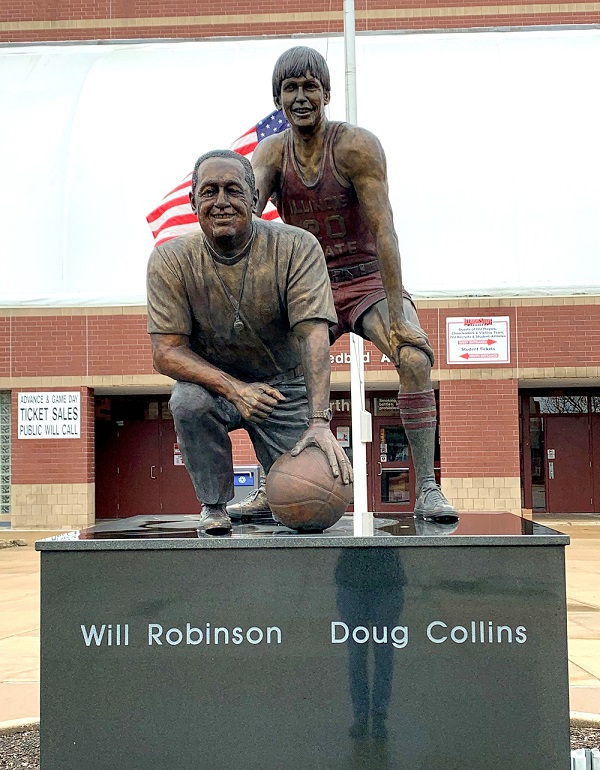 A pair of free throws by Paige and two additional baskets by Hawkins capped the upset.
A pair of free throws by Paige and two additional baskets by Hawkins capped the upset.
At the final horn, fans mobbed the team. According to Schram, the celebration “rivaled the famed Lansing Sexton – Hamtramck classic of a decade (previous) when the winning shot dropped in overtime after the buzzer.”
Following the game, Robinson, now ready to start recruiting for the future, pitched Russell for his services:
“You’re going to come down to Illinois and play for me, aren’t you? You’ll be All-American and we’ll win the NCAA.”
Illinois bound
The team chose to celebrate the title at a Big Boy restaurant. Then Robinson departed for Normal, Ill., appearing before the local Jaycees that Monday night.
“I’m glad the opportunity came along,” Robinson said before his departure. “I just wish it had come along in Michigan. I never was offered a college job here.”
Robinson had bid for several college coaching positions in the past, only to be turned down.
“I love this country. I wouldn’t want to live anywhere else in the world, I’m just sorry it has a blind spot.”
 Ron Pesch has taken an active role in researching the history of MHSAA events since 1985 and began writing for MHSAA Finals programs in 1986, adding additional features and "flashbacks" in 1992. He inherited the title of MHSAA historian from the late Dick Kishpaugh following the 1993-94 school year, and resides in Muskegon. Contact him at [email protected] with ideas for historical articles.
Ron Pesch has taken an active role in researching the history of MHSAA events since 1985 and began writing for MHSAA Finals programs in 1986, adding additional features and "flashbacks" in 1992. He inherited the title of MHSAA historian from the late Dick Kishpaugh following the 1993-94 school year, and resides in Muskegon. Contact him at [email protected] with ideas for historical articles.
PHOTOS: (Top) Detroit Pershing players and coach Will Robinson celebrate their 1970 Class A championship win. (2) Coach Will Robinson, in 1958 while at Detroit Cass Tech. (3) Detroit King’s George Gervin, who would go on to star in the NBA. (4) Kettering’s Lindsay Hairston, who along with Campy Russell, was among the most sought-after players in the state; he would ultimately take his game to Michigan State. (5) Rick Drewitz of Garden City. The son of a junior high principal, Drewitz chose to play college ball at the University of Kentucky choosing that program over Michigan, Wisconsin, Louisville and Toledo. (6) Considered the top prospect in the nation, Campy Russell received offers from at least 100 schools before selecting University of Michigan. He had narrowed his list to Michigan, Michigan State, Minnesota and Long Beach State. (7) The game program for the final rounds of the 1970 MHSAA Boys Basketball Tournament. (8) The 1970 Detroit Pershing team photo. (9) The Will Robinson-Doug Collins statue outside the north entrance of Illinois State University’s Redbird Arena, unveiled in September 2009. Calvin Harper, Phil Paige, Robert ‘Bubbles’ Hawkins, and Darrel Jeter from Pershing would all follow Robinson to ISU. (Photos collected by Ron Pesch; statue photo by Allison Antink Meyer.)

